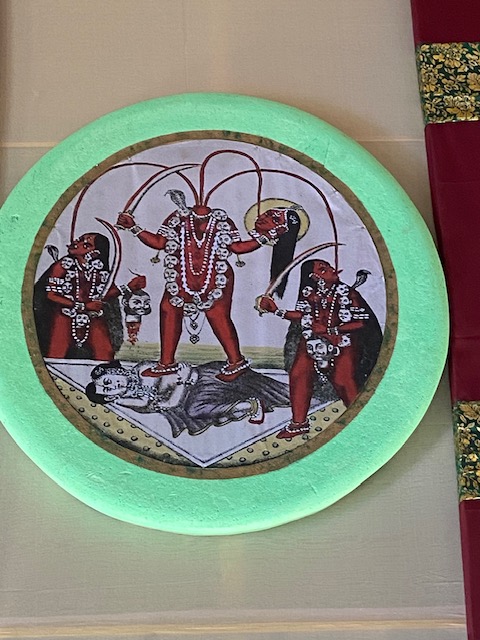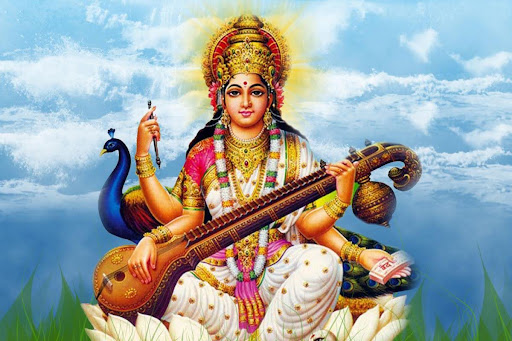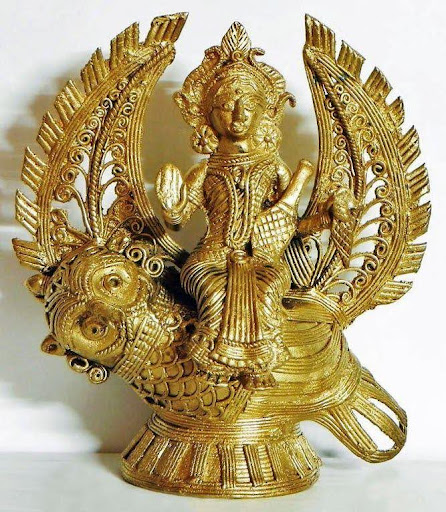Try as I might, I just couldn’t shake off the idea of the feminine divine. I admit that I don’t have perfect clarity on this fixation. All I knew is that there appeared to be an enormous chasm in my understanding between the godliness defining the goddess figure from the sheer hypocrisy with which she manifested in the real world. And so it was only appropriate to do due diligence by thoroughly sweeping through Kurt Behrendt, Vidya Dehejia, Devika Singh, and Stella Kramrisch. But try as I might, every attempt to figure out what the feminine divine is in Hindu life and art was met with a fog of resistance. And as if this curse was not bad enough, on the day of my presentation on the feminine divine at the Cincinnati Woman’s Club, my Word document vanished in one plop of a sound byte. It was as if it was not meant to be. It was 4:06 in the morning, and I had woken up feeling somewhat settled and composed. But that feeling withered away in a nanosecond. Everything changed. Suddenly, I was left with a blank slate in which to create a version of what I believed to be true.

Skulking in the blare of my computer screen, I reconstructed word by word my ideas of the feminine divine. As I did so, I realized that my insights on the topic were juvenile at best, or compassionately stated, emerging. I knew that I had plenty of skin in the game, having been brought up in a traditional, conservative Brahmin family that was famous for abiding by the letter of the law. But the endless divide between the idea of the goddess and the practice of it in an actual setting kept confounding me. Relentlessly.
On my blank slate, I chose to become clear-eyed about all the things that I didn’t know and perhaps would never know about the feminine divine. Who was she, this goddess figure? What was her role in life and art? How did she hold a mirror to those in the living world? Was there even a place for her in our 21st-century world? And the questions continued at a tripping pace.
I don’t know if there are answers to every question that pops up in our mind or if we are meant to be in the dark about the Mysteries of Life. But that didn’t stop me from reconstructing a vision of this layered complexity where women are both revered as a goddess figure and minimized, sometimes brutally, for being who they are. She is at once a patriarchy-endorsed mother figure providing sustenance and comfort in the world. Simultaneously, she is also responsible for holding up half the sky, as Nicholas Kristof aptly noted in his study of gendered identity in the Chinese ecosystem. If our goddess figure exerts agency in the world, she is bound to come up against physical and psychological tribulations that are well beyond what is considered acceptable or reasonable. At the same time, there is enormous pressure to maintain the status quo, to let our gendered identities know their place in our homes and workplaces alike. Go figure!
Going back to the recent scholarship, Dehejia, Kramrisch, and others tell us that among God-fearing Hindus, the goddess exists as a living legend, a woman larger than life and worshipped for the ideal she represents. Still others suggest that the goddess bears a social agency in modeling how women should be. But can this drive toward the ideal triangulate into what’s real in the living world? Can this figure cohabit simultaneously the spirit world as an idea and a living world as a real thing, a woman who lives in accordance with her potential? Can she unperch herself from our living altars as an object of reverence and descend into the rough and scramble of a life lived? Can these precarious twains ever meet?

Judging from recent events in India, I think not. But I am getting far ahead of my story. First, I have to unpack, albeit in very broad brushstrokes, how our ideal image of divinity is forever held up in our imagination as a source of emulation and inspiration. This ideal is our gold standard, and to me, it appears as a hollow monolith that is forever locked into an ongoing fight with the reality that surrounds it.
To come to terms with all this stuff, I recounted all the things that I did know about the feminine divine. I listed, sorted, and categorized to come to a few scratchy pieces of evidence.

I came to see that the idea of the feminine divine is as old as recorded history. When did it officially enter the canon? Who were its originators? Did any defining text, like the Quran in Islam or the Bible in Christianity—form the core of its belief system? No one knows the answers. But one does know that the idea of the feminine goddess, forming the central core of Hinduism, is likewise older than recorded history itself.
In its early stages, Hinduism seems to have placed a huge premium on the worship of the goddess. She was way more important than her male counterpart, and where the male was allowed presence, it was often as an Ardhanarishvara—a half goddess, half god figure, that existed only in collaboration. Wikipedia notes that festivals, such as Vasant Panchami, Navaratri, and Dussehra, are wholly dedicated to goddesses. The Rig Veda contains hymns composed by women such as Lopamudra and Maitreyi. Hindu epics such as the Mahabharata and Ramayana idealize women, embodied by depictions of Draupadi and Sita. It is common lore that for a Hindu to find transcendence in life, one must have visited Madurai’s Meenakshi, Kanchi’s Kamakshi, and Varanasi’s Vishwalakshmi—shrines glorifying the goddess Shakti. In these ways, Hinduism remains one of the few major religions in which women have occupied respected positions in spiritual leadership.

Through the Shilpa Shastras, we come to know that Hindu art is a highly stylized ideal and does not bear any resemblance to reality. The idea of copying—of being derivative—was the greatest skill that an artist could perfect as well as the highest compliment that they could bestow upon their master. There is little emphasis placed on being original or unique because this is not relevant to the practice. Rather, the emphasis on following tradition and adhering to its stylistic history was observed carefully and diligently. For this reason, the artist is anonymous till much later in the evolution of Indian art. And for this reason, much of the representations of the goddess follow a prescription, an ageless tradition that is known to our ancestors as they may be to our grandchildren.
The ways in which the goddess is represented are outlined in an important guide of aesthetics, the Shilpa Shastras. This text is not a standalone book; rather, it is a composite of numerous prescriptions scattered through the breadth of Indian scriptures. The Shilpa Shastras define in detail the practice of the arts and crafts, and their design rules, principles, and standards. It ranges in description from the creation of perfume and the architectural construction of a temple to the proper proportions of the human figure and the composition of dyes. The entire gamut of artistic expression as manifested in real life is to be found here.


In Hindu aesthetics, the goddess gives very little away, so uniform and unreadable are her facial expressions. Rather, the gestural language of her hands and feet, her spirit animal, and her standing or seated position provide evidence of her mental landscape. What is the storyline? The defining theme of this moment in time? How is she thinking? How does this affect the trajectory of the viewer? Through an analysis of the entire picture frame, we come to know that this is her calling card. Through these stylized semaphores, she conveys information on what’s going on and how she is of relevance to us.

The Goddess in Worship
The feminine divine plays a central role in Hindu cosmology where she is worshipped as Shakti or the Divine Mother. God as a Mother Goddess is responsible for the well-being of the Universe and is considered the embodiment of incredible power.
The Hindu tradition also considers women the vessels of shakti. This identification with shakti acknowledges women as the containers of both creative and destructive power. Some feminists and scholars criticize this identification because they believe it has led society to label women either as saints or sinners, with little room for nuance in between.

The feminine divine is at once a mother and a shrew, an annihilator as well as a giver of the life force. She is everything everywhere all at once. Her mandate is all of the above: to give hope; to uphold the powers of womanhood; to serve as an unabashed sex symbol in her clear affirmation of the beauty of the female body; to be a superpower when she wants to be one and self-effacing when she is not up to it. Her everything everywhere state of mind is reflected in the breadth, range, and scope of her being. She is comfortable being who she needs to be and in this way, she provides purpose to those around her.

Goddesses Come in All Forms
In the Hindu pantheon, we get to choose the figure who most resonates with our inner self. Thus, goddesses come in all forms from the fair-skinned and demure Gauri, with curvaceous hips and full breasts, to the ferocious crone, Chamundi, who lives in cremation grounds with predatory animals like jackals and vultures.
Durga is the fierce warrior who rides her lion into battle at a time of crisis at the behest of the male gods. She slays the evil Buffalo Demon who is threatening to destroy the world.

When things get rough, Kali appears as the terrifying dark-skinned goddess with wild hair, blood-dripping fangs, a skirt of human arms, and a necklace of skulls. She arrives to cleanse the world of evil and to provide space for new beginnings.
Yogini or Dakini is the archetypal dangerous female associated with the darker or more wrathful manifestations of the goddess. She personifies extreme and unorthodox practices that can be terrifying. In a different time and place, women have been demonized as witches and have been burned at the stake. Perhaps this fear of yoginis reflects the cultural fears within orthodox Hindu culture of female sexuality and power.

In the end, much of these ideas exist as just that: ideas. To the faithful, perhaps this is enough of a guide to see one through. In the context of 21st-century complexities surrounding the Indian woman, it may be said that India has not lived up to the Hindu ideal of gender parity and mutual respect. The country is deeply entrenched in patriarchal sometimes archaic norms where women are largely unseen, unheard, and unacknowledged. Often, her efforts at autonomy do not end well. All of this can be contextualized with the disclaimer that among the educated, the Indian woman is generally recognized for who she is. Among the vast population of the illiterate, neanderthal ideas still run deep. Change comes very slowly if at all.
In the end, the conundrum continues to baffle ordinary folks like me. What is the value of an idea, I ask myself? Can perfection be achieved or sustained in the material world? Is the opposite of reality, another reality, that is humanly off-limits to our understanding of things?







